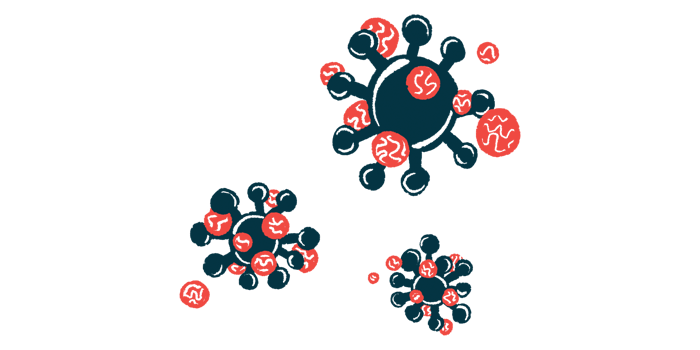Experimental Antibody GNK301 Shows Promise in Treating ALS

A viral protein called HERV-K ENV is often detectable in the fluid around the brains of people with amyotrophic lateral sclerosis (ALS), and is toxic to nerve cells, a new study shows.
However, blocking this protein with GeNeuro‘s experimental antibody GNK301 reduced those toxic effects in cell and animal models of the disease, indicating it may be a promising treatment approach for people with ALS.
The study, “HERV-K envelope in spinal fluid of Amyotrophic Lateral Sclerosis is toxic,” was published in the Annals of Neurology. The work results from a collaboration between GeNeuro and the National Institute of Neurological Disorders and Stroke, part of the National Institutes of Health (NIH).
“This publication … underlines the relevance of GeNeuro’s approach to sporadic ALS via its novel monoclonal antibody that inhibits the neurotoxic effects of the HERV-K ENV protein, an endogenous toxin detected in the cerebrospinal fluid of patients,” Hervé Perron, PhD, scientific director of GeNeuro, said in a company press release.
About 8% of the human genome is not human, technically; the genetic code contains a number of endogenous retroviruses, where bits of viral DNA from prehistoric infections became integrated into the human genome. Long dismissed as “junk DNA,” emerging evidence is uncovering the many roles these pieces of viral DNA play in human development and disease.
Human endogenous retrovirus K, or HERV-K, contains the genetic code to make an envelope protein — so named because it typically would act as the outer shell of the virus. Usually, the HERV-K ENV protein is not produced in human cells, but recent evidence has shown it may be activated in people with ALS. How it may contribute to the disease has been unclear.
Prior work has established that the HERV-K ENV protein is detectable in brain samples of ALS patients. Here, scientists at GeNeuro and the NIH tested whether the protein also is present in the cerebrospinal fluid (CSF), the liquid that surrounds the brain and spinal cord.
Study participants had sporadic ALS
The researchers checked for HERV-K ENV in the CSF of 14 people with sporadic ALS and 10 healthy volunteers. The viral envelope protein was detected in 11 of the ALS patients, and just one of the healthy volunteers.
In initial cell experiments, the researchers treated neurons with increasing amounts of the viral envelope protein. The treatment reduced overall neuron counts by up to 40%, and the surviving neurons were less electrically active and had shorter neurites (the wire-like projections nerve cells use to connect with each other).
Notably, co-treatment with GN-K01, an antibody designed to bind to the envelope protein, could prevent these neurotoxic effects in the cell models. Experiments done by injecting the envelope protein plus antibody into the brains of mice yielded similar results.
These results imply that the toxic effects of HERV-K ENV are mediated by the protein physically interacting with nerve cells, which could be blocked by the antibody sticking to the protein instead.
The scientists also tested whether the CSF from each of the ALS patients was neurotoxic in cell experiments. Several of the samples were neurotoxic, though there was no clear association with neurotoxicity and levels of HERV-K ENV.
“While the toxicity of the recombinant [lab-made] protein was concentration dependent, progressed over time, and was associated with functional deficits observed by electrophysiological abnormalities, the toxicity of the CSF did not parallel the concentrations of the” envelope protein, the researchers wrote.
Notably, however, in two of the three most toxic CSF samples, the addition of GN-K01 could reduce the sample’s toxic effects. This indicates “that the observed neurotoxicity [of the CSF samples] was specific to Env, as it was blocked by a monoclonal antibody specific to the Env protein,” the researchers wrote.
In subsequent experiments, the researchers screened for proteins on nerve cell membranes that physically interacted with the HERV-K ENV protein, and they identified two: CD98HC and beta-one integrin. Using an antibody to block the CD98HC receptor could reduce neurotoxicity caused by the envelope protein, implicating this receptor as a mediator of the viral protein’s neurotoxic effects.
More studies anticipated
The researchers also conducted a broad screen for cellular pathways involved in the toxic response, identifying several as promising candidates for future mechanistic studies — namely GSK3-beta, retinoic acid receptor, cyclic AMP, and oxidative stress pathways. The team noted that other mechanisms also may be involved in mediating the protein’s toxic effects.
The scientists concluded that the HERV-K ENV protein “is released extracellularly into the CSF of patients with ALS and can mediate neurotoxicity via interactions with CD98HC and the associated secondary signaling pathways.”
“Further characterization of these mechanisms may help identify additional therapeutic targets,” they added.
The company has already created an antibody that can be manufactured in large scale for clinical testing, and is looking for potential partners for the clinical development of GNK301.
“We now want to move forward as quickly as possible to provide what could be a treatment that changes the prospects for patients,” added Perron.







